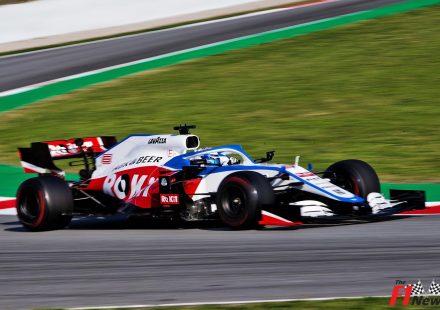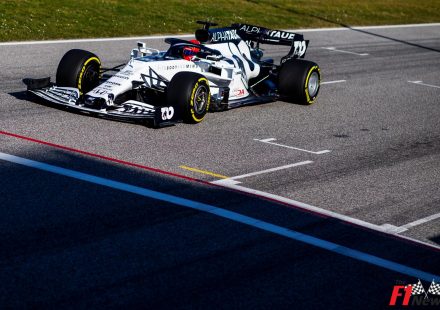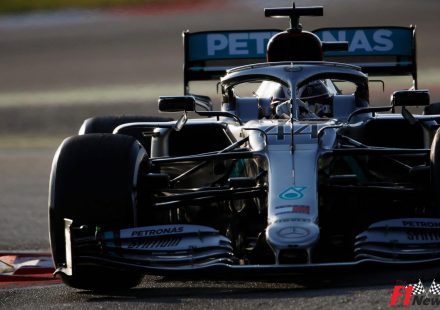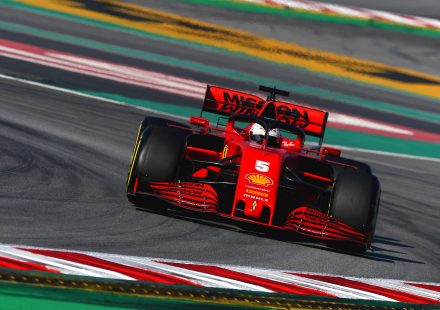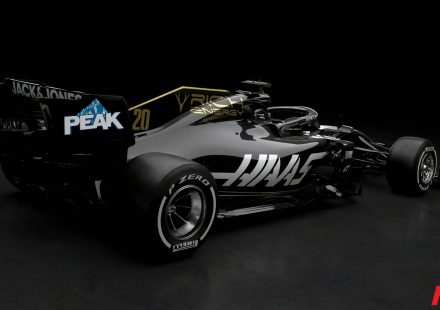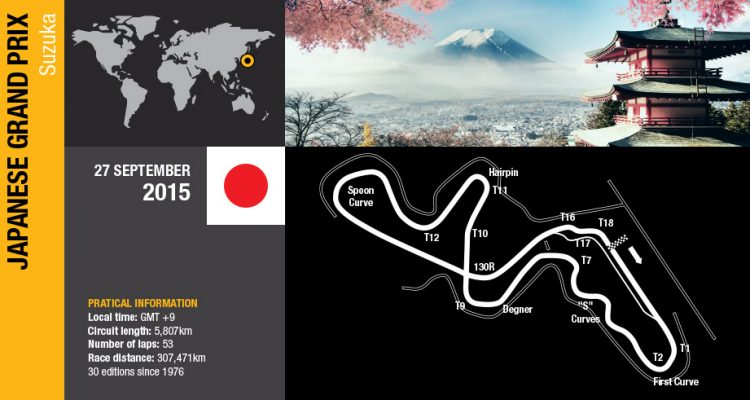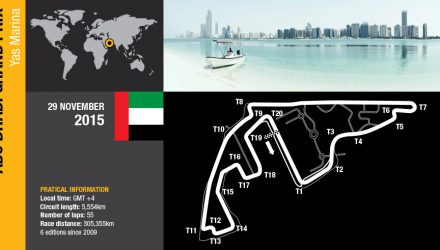RÉMI TAFFIN, DIRECTOR OF OPERATIONS
Suzuka is one of the toughest circuits of the year for the power units. It has just about every type of corner imaginable, from flowing radial turns to hairpins and chicanes, and fast swoops. The average speed is also very high and top speed peaks at over 340kph, so every part of the units is put under pressure.
The result in Singapore shows that the performance is there and having introduced new parts earlier in the season we are confident in the reliability, but also the flexibility we have in our engine plans. While we are expecting Mercedes to be back on form in Japan we are hopeful we will be close enough to use the improved performance to get some good results.
RENAULT 2015 FAST FACTS
The strong braking, frequent acceleration and high speed sections of Suzuka take fuel consumption to the upper limit, but there are plenty of opportunities for the K and H to recover energy under braking and therefore recharge the battery, bringing the fuel consumption within the allowed limits.
Similar to Silverstone, engineers may use the practice of ‘overloading’ where slightly more fuel than necessary is put into the ICE. Running the ICE at a higher average fuel flow produces more overall power, which in turn allows the MGU-K to recover more energy to recharge the battery in order to match the driver demand, which leads to a better lap time.
Renault has won 10 Japanese Grands Prix. The first came in 1992 at the hands of Riccardo Patrese, with Damon Hill winning in 1994. Michael Schumacher took victory in 1995, and Hill again in 1996. Fernando Alonso won in 2006 and 2008 while Red Bull Racing have stood on the top step four times.
Renault has also powered 10 pole positions at the track, including five consecutive poles for Red Bull Racing between 2009 and 2013.
Suzuka is known for being a championship decider and Sebastian Vettel became the youngest back-to-back champion, and youngest double champion in F1 history in 2011.
FOCUS ON…PACIFIC GRAND PRIX 1995
The Japanese Grand Prix has been held at two tracks in its history; the figure-of-eight Suzuka Circuit we visit this year and the Fuji Motor Speedway named after Japan’s most famous mountain. However a third Japanese track has also hosted a round of the championship. Aida, a twisty, remote track close to Kobe hosted the Pacific Grand Prix in 1994 and 1995. The ‘94 race was held early in the season, but the 1995 event was third to last, having been moved to the end of the year following the Kobe earthquake.
The season shuffle saw Aida play a decisive role in the title race, as Christian Blum, a Renault engine engineer dedicated to the Benetton team at the time, remembers:
‘Aida was one of the last rounds of the season in 1995. We went there with Michael (Schumacher) in a position to win the drivers’ championship for the second time, but the first with the Renault engine. Damon Hill still had a mathematical chance of taking the title, but we knew it would take a lot of bad luck for us to lose.
‘The race weekend turned out to be a microcosm of the season. Williams were always strong in qualifying, but we were stronger in the race. Yet again the Williams locked out the front row of the grid, with David Coulthard outqualifying Damon Hill this time. Michael was third, then the two Ferraris, the Jordan of Eddie Irvine and finally the sister Benetton of Johnny Herbert in seventh. To win the race we needed a good strategy, particularly as Aida was a notoriously difficult track to overtake on.
‘This was one of the advantages of the Benetton team. Remember this was the days of mid-race refueling so there was everything to gain by being creative. Ross Brawn was an excellent strategist and had developed sophisticated programmes that took into account tyre degradation, fuel consumption, track position and other variables. It is standard stuff now, but at the time it was very, very clever.
We knew that Williams had the same engine as us, and arguably a more technically advanced chassis, but they were very conservative in their pit strategies. Ross knew this, and saw an opportunity to take advantage.
‘The race got underway. Coulthard led from pole, but Michael tried a move on Hill. It didn’t stick and he dropped back down to fifth behind Hill and the two Ferraris. We needed a good strategy to move up; Michael had already tried a move on Damon but it hadn’t worked. Then Hill, Alesi in the Ferrari and Michael came in on the same lap.
They came in with Michael last of the three, but rejoined with Michael in front!.Michael was now fourth behind Coulthard, Berger and Herbert. He started to put in the fastest laps, closing the gap, and made his second stop. Knowing Coulthard was on a two stop strategy, and that he had a third stop to make, Michael went faster still. When he made his third and final stop he was over 20secs ahead and able to exit in the lead.
‘It really was a testament to how Benetton worked as a team. Ross Brawn knew when to take risks, but he also knew when to push Michael to go faster. They probably could take credit for inventing the undercut we use today: stop early, take track position and then put the hammer down. Michael knew when to respond, how to conserve his tyres and wait for the right time, but he was a very willing contributor to the strategy too.
They had a real dialogue about the calls and, very often, made the right ones. The calmness with which they made them was impressive – when you listened on the radio, it was as though they were talking in their lounge about sport!
‘Michael held on to take the win, and his second title. We were absolutely delighted. The competition between the engine teams at Williams and Benetton was extremely fierce and sometimes got quite heated! Everyone knew that Williams had the best car and other teams, such as McLaren and Ferrari, had better budgets. But Benetton knew where to make a difference.
Where they could compensate. For example, there was no point spending more millions on aero when you could make up the time in pitstops. So they trained and trained and invested in the best equipment. As a result it was very gratifying to take the title as everyone in the team, Renault included, had worked exceptionally hard.
‘For Renault, taking a second title justified our investment. The decision to supply Benetton had not been an easy one and there was certainly a lot of resistance to it from Williams. It wasn’t easy as the teams were essentially each other’s main opponent. But they could not have been more different – on the one hand Williams was the traditional British team, on the other Benetton was run by a flash Italian with a penchant for fashion, polo, girls, music…
‘But we made it work in both cultures. In 1995 we won 16 of 17 races between Williams and Benetton and took 16 of 17 poles. The following race in Suzuka we went on to win the constructors’ title and the satisfaction was complete. But my overriding memory of that season is the party after the drivers’ title in Aida. The track was in a remote location and everyone was staying in guest houses some way from the track.
There was the drivers’ hotel at the circuit though so Flavio reserved the entire restaurant straight after the race. On one table you had Flavio, Michael and the Renault bosses. On another table there was Johnny’s crew. We finished in the early hours of the morning, still in our team kit. It’s still my best-ever memory from the sport. We had worked hard, as a team, and got the result we wanted.’
POWER UNIT DETAILS
ICE
Suzuka is one of the toughest circuits of the year for the ICE. The sustained bursts of throttle test the internals’ strength, while the heavy braking events challenge reactivity and reliability.
Over 60% of the lap is taken at full throttle, but the majority of this comes in the second half of the track from the exit of the Spoon corner (Turn 14) to the chicane on the entry of the pit straight. This includes a pass through the 130R, which is taken at over 300kph despite being a flowing left hand bend!
The distance from Turn 14 to the chicane is 1,250m, equivalent to over 20% of the track. The driver will cover this distance in around 17secs, or 75m each second, roughly equivalent to the record speed reached by the Japanese bullet train, the Shinkansen.
With a top speed peaking at almost 340kph, Suzuka gives rise to one of the highest speed seen in the second part of the year. Inside the ICE the pistons will turn at an incredible 200 times per second, generating enormous internal forces.
TURBOCHARGER
Suzuka features several changes of altitude. The most obvious uphill section is through the Esses/Dunlop where the circuit rises by 25m. This impacts the turbo most of all, as it will rotate at a higher speed at the crest of the hill than at the bottom to produce the same amount of power. Engineers will factor this in when looking at turbo speeds throughout the lap.
MGU-K
Good performance at Suzuka is as much about traction in the slow corners as it is about top speed. The two slowest corners, Turn 11 (the hairpin) and the chicane, require accurate torque delivery to avoid wheelspin when the grip is low. They also provide opportunity for the MGU-K to recover energy under braking.
The second slowest corner is the chicane, which is taken at approximately 80kph. This is the best chance to recover energy as the cars approach at well over 330kph. Braking down to under 100kph generates huge amounts of heat and energy in the brakes. At this point there is even excess energy that engineers are not allowed to recover as a result of the regulations.
MGU-H
The flowing section of the Esses gives the MGU-H plenty of time to recover energy through the constant exhaust stream. Similar to Silverstone’s Maggotts and Becketts, the driver enters the complex at approximately 240kph and carries the speed through until the exit of the complex. He will spend approximately 15secs in fifth or sixth gear through this section.
Other than the two main straights, the Spoon Curve is another chance for the MGU-H. The driver enters Turn 13 at around 290kph and shifts down, but then quickly blips the throttle while turning in for Turn 14. The radial turn sees the driver at partial throttle for just over 5secs.

